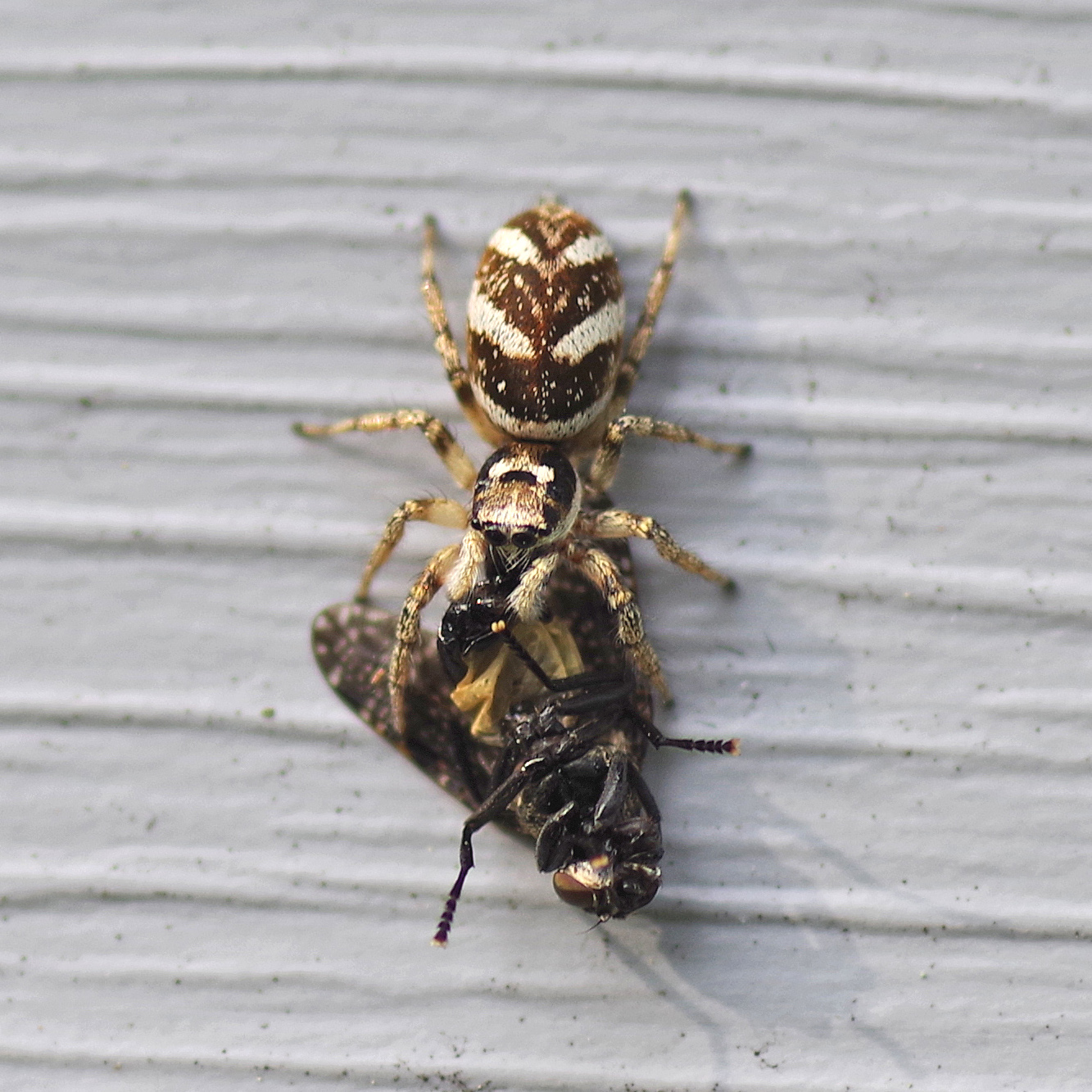
by Kate Redmond
Zebra Jumping Spider
Greetings, BugFans,
The BugLady was moseying around her cottage, photographing doodlebug digs, when she spotted this very small (maybe ¼”) jumping spider with its prey. It was on a sunny, south-facing wall – right where it was supposed to be!
Zebra spiders, aka Zebra jumpers (Salticus scenicus) are in the family Salticidae, the Jumping spiders. Salticus is Latin for “dancing,” and scenicus is Greek for “theatrical” or “of a decorative place,” and refers to the spider’s flashy colors, which can look iridescent in the right light. Thanks to BugFan Mike, as always, for the ID.
We’re on a roll here, having recently introduced the non-native Clover weevil and the (probably) non-native American Copper butterfly. The Zebra spider’s original range included Europe and western Asia. It was first collected in North America (in Illinois) in 1933, and now it occupies most of the northern two-thirds of North America. It’s an urban spider that loves the sun-warmed sides of buildings, but it’s also found away from human habitation, on bare rocks.
There’s some variation in pattern and color, and spiders that live in polluted urban areas may be all black. Here’s a side view https://bugguide.net/node/view/1339892/bgimage. Males have large, black jaws called chelicerae https://bugguide.net/node/view/2251820/bgimage. Like all jumping spiders, Zebra spiders have appealing (some say cute) faces https://bugguide.net/node/view/171573/bgimage – jumping spiders have fan clubs and Facebook pages, largely because of the size and arrangement of their eyes.
Jumping spiders have eight eyes, four facing forward and four facing upwards – they have depth perception, can judge distances, and can see in color. Research suggests that when the lateral eyes on each side of those big median eyes pick up motion, they tell the median eyes where to look. The four eyes on top of the head (cephalothorax) sense movement (helpful for dodging predators) and light.
Zebra spiders don’t spin for their supper, they jump (and they can jump as far as four inches). They stalk their prey brazenly by creeping directly at it, but if their prey is much larger than they are, they sneak up from behind. Either way, they attach a silken drag line to the substrate as they leap, in case they miss or in case they and their prey tumble over the edge. They bite, subdue, and eat their prey on the spot – they don’t wrap and store it because they have no web to store it in.
What do they eat? Various kinds of flies, including mosquitoes, are favorites https://bugguide.net/node/view/1811146/bgimage, but they go after insects that are much larger than they are https://bugguide.net/node/view/228175/bgimage and https://bugguide.net/node/view/383371/bgimage. They find ants distasteful, but they will eat their fellow spiders https://bugguide.net/node/view/284184/bgimage.
Females attract wandering males with pheromones, and courtship is visual – males dance, and the best dancers win. Faint heart ne’er won fair maid. He waves his front legs and chelicerae and displays his patterned abdomen (so that she doesn’t think he’s prey). If she’s impressed (and scientists don’t know exactly which moves will light her fire), she’ll crouch and let him approach. Sometimes males mistakenly display in front of other males, which results in ritualized battles that are won by the most aggressive fighter.
She produces a silken sac that holds 15 to 20 eggs and hides it under leaves or debris, and she guards it until the eggs have hatched https://bugguide.net/node/view/236348/bgimage. The spiderlings stay with her until after their second molt, and then they disperse. They overwinter as almost-mature spiders and may live for a year or two.
Fun Facts about Zebra Spiders:
1) Their jumps are driven not by muscles, but by hydraulic pressure – the spider increases the pressure of its haemolymph (blood), and that causes the 4th set of legs to straighten, which propels it off the ground. The fact that the spines on a spider’s leg stand up as its legs straighten is considered proof of that explanation.
2) Zebra and other jumping spiders can abseil/rappel down walls and rock faces.
3) Cushions of hairs on the bottoms of their feet have adhesive qualities and allow them to walk on smooth, vertical surfaces.
4) Zebra jumpers operate during the day, and they retreat into silk shelters spun in crevices and under leaves and bark by night.
5) Vibrations (like buzzing wings) help Jumping spiders recognize their prey.
6) If a Zebra spider accidentally comes inside, it might take up residence in the corner of a window. No – it can’t bite us – not even a little bit.erved by a large jumping spider that was inside the car as she drove, alternately staring at her (jumping spiders are good at that) and then disappearing as she drove (that, too).
Kate Redmond, The BugLady
Bug of the Week archives:
http://uwm.edu/field-station/category/bug-of-the-week/
